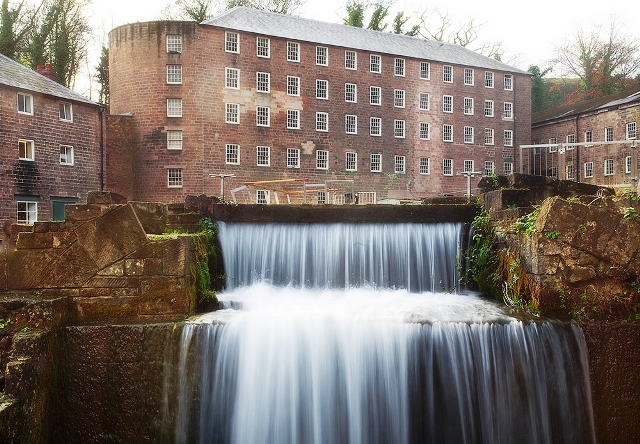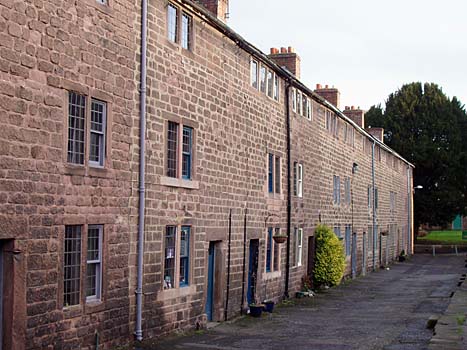
(Note: click on the numbers, in parentheses, to see the relevant image)
In the mid-Eighteenth Century Richard Arkwright,(1) a wig maker from Preston, perfected a wacky new machine to spin strong cotton yarn suitable for use as both the warp and weft when weaving fabric on a loom. Not only could one of these ‘spinning frames’ spin lots of threads at once, but many of them could be linked up to a power source, so producing really large quantities of yarn. In order to develop his ideas, Arkwright came to Cromford near Matlock, an isolated area in the Derbyshire hills with an unlimited supply of fast flowing water from a hill stream and the drainage sough (channel) of a lead mine. He built a small manufactory, filled it full of water frames, linked them all to a water wheel, was soon turning out more yarn than he could have dreamed of, and was making a great deal of money.
His ideas were capitalised on  by many others, including our own Samuel Oldknow, who was a friend of Arkwright and relied on him heavily for financial support. With Samuel in the news in Marple at the moment because of the ‘Revealing Oldknow’s Legacy Project’, it seemed fitting for the Marple Local History Society 2017 Summer Outing to take us to Cromford. So, on 28th June, we set forth. On the face of it, things did not bode well. Heavy rain was forecast for the whole day. The previous evening the coach company had phoned to say that the end of the road to the mill was closed because of road works, meaning a long detour to reach our destination, and further, that our projected homeward route was closed for three weeks because of a rock fall! However, there was a cheerful air of expectation as everyone boarded the bus, the coach driver had solutions to the road blockages, and we couldn’t do anything about the rain, so we stopped worrying.
by many others, including our own Samuel Oldknow, who was a friend of Arkwright and relied on him heavily for financial support. With Samuel in the news in Marple at the moment because of the ‘Revealing Oldknow’s Legacy Project’, it seemed fitting for the Marple Local History Society 2017 Summer Outing to take us to Cromford. So, on 28th June, we set forth. On the face of it, things did not bode well. Heavy rain was forecast for the whole day. The previous evening the coach company had phoned to say that the end of the road to the mill was closed because of road works, meaning a long detour to reach our destination, and further, that our projected homeward route was closed for three weeks because of a rock fall! However, there was a cheerful air of expectation as everyone boarded the bus, the coach driver had solutions to the road blockages, and we couldn’t do anything about the rain, so we stopped worrying.
Arriving on time, and after morning refreshments, we met Cliff Lee,(2) our principal guide for the day. Cliff gave us an excellent illustrated talk about Arkwright’s invention, including a demonstration of how it worked, using their model water frame.(3) He then went on to explain the system Arkwright developed using a lot of machines worked by operatives for specified amounts of time for which they were paid a wage. This, of course, was the basis of the factory system and the start of the Industrial Revolution, which changed everybody’s working and everyday life at a stroke, for ever.
We then went into Arkwright’s prototype mill, the first water powered cotton spinning mill (4) in the world, where we met a virtual ‘Mr Arkwright’ (5) and heard him talk about his activities.
 A tour of the mill yard to look at the way water power was harnessed, and to understand the significance of all the buildings, occupied us for the rest of the morning, and by then we were good and ready to retreat into the warmth of the mill café and to enjoy some of their excellent homemade lunch fare.(6)
A tour of the mill yard to look at the way water power was harnessed, and to understand the significance of all the buildings, occupied us for the rest of the morning, and by then we were good and ready to retreat into the warmth of the mill café and to enjoy some of their excellent homemade lunch fare.(6)
In the early afternoon we walked into the village. When Arkwright built his mill in 1771, there was no defined settlement here, just a scattering of hill farms and lead mines. Where was he to find the many workers he needed for his factory? He solved his dilemma by starting to build a village complete with houses, (7) market place,(8) a lock up to keep everyone in order, an inn for visitors, and school. (9) It must have provided high class facilities in the 1770s: the houses are still sought after today, and the primary school continues to operate in the original building. We also saw the mill reservoir, (10) and the ingenious ‘water junction’, the 'bear pit sluice' (11) for control of the mill supply from the hill stream and the lead mine drainage sough.
Back at the Mill, Cliff took us to St Mary’s Church, (12) also built by the Arkwright’s as there wasn’t a church when they first arrived. The exterior is rather austere, but there are some beautiful Victorian wall paintings, recently restored, and some significant memorial plaques to members of the Arkwright family. (13) (14)
There was enough time left to look in the mill shop, and grab that essential cup of tea before the journey home. We avoided the rock fall by going home through Chatsworth Park, with a nice view of Chatsworth House, and over the limestone plateau via Peak Forest.
 The weather was disappointing as it hardly stopped raining all day. But MLHS members are made of stern stuff, (15) and the plentiful supply of brollies prevented anyone getting too soggy and added colour to photos on a rather grey day. The excellence of our guides, and the quality of the restoration of the mill site, made this a day to savour, with its many connections with Samuel Oldknow and ‘Revealing Old now’s Legacy’.
The weather was disappointing as it hardly stopped raining all day. But MLHS members are made of stern stuff, (15) and the plentiful supply of brollies prevented anyone getting too soggy and added colour to photos on a rather grey day. The excellence of our guides, and the quality of the restoration of the mill site, made this a day to savour, with its many connections with Samuel Oldknow and ‘Revealing Old now’s Legacy’.
For me it was a day of nostalgia. The first visit I organised for Marple Local History Society was to Cromford on 22nd June 1996. There have been many since – 83 more, in fact. There have been very few problems, and most of it has been an absolute delight.
Thank you for your support over the years, because without all of you, there couldn’t be any trips at all.
Judith Wilshaw
Visits Organiser,
Marple Local History Society
Photos: David Burridge & Judith Wilshaw
A video: ATV Today 4th March 1981 - Arkwright Mill, Cromford, Derbyshire
















